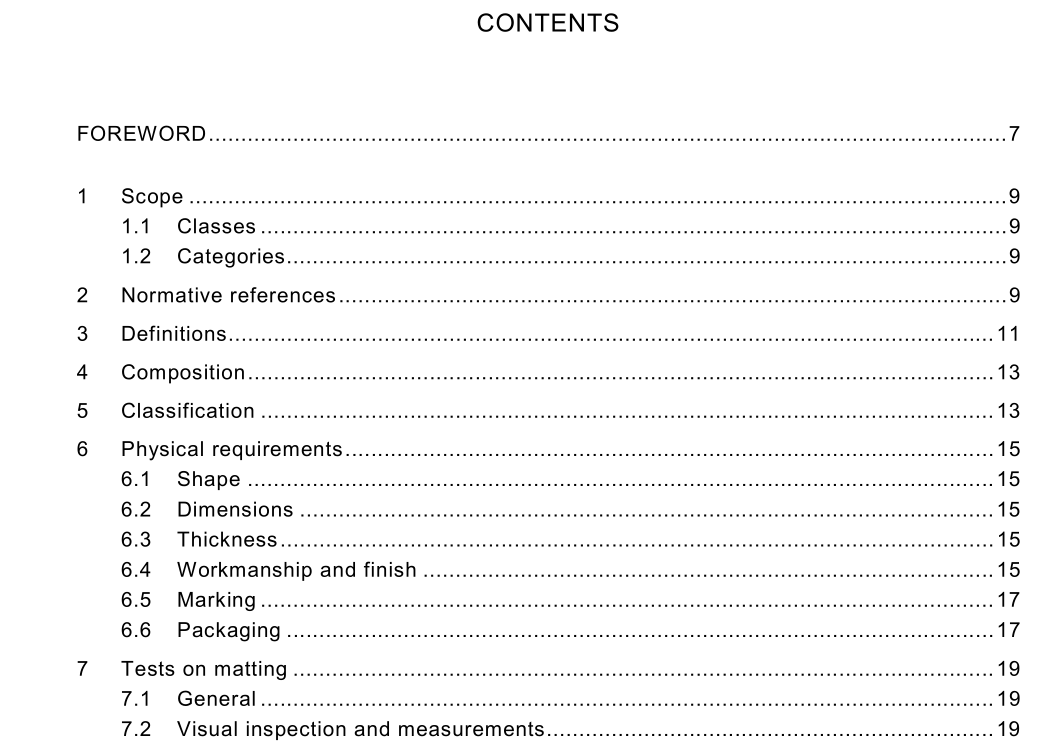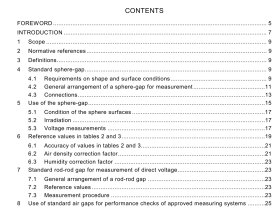IEC 61111 pdf download

IEC 61111 pdf download.Matting of insulating material for electrical purposes
1 Scope
This International Standard is applicable to insulating matting made of elastomer for use as a floor covering for the electrical protection of workers on a.c. and d.c. installations. 1.1 Classes Five classes for matting, differing in electrical characteristics, are provided and designated as: class 0, class 1, class 2, class 3 and class 4. 1.2 Categories All matting shall be resistant to acid and oil, and low temperature; a category C of special property shall be resistant to extreme low temperature.
2 Normative references
The following referenced documents are indispensable for the application of this document. For dated references, only the edition cited applies. For undated references, the latest edition of the referenced document (including any amendments) applies. IEC 60050(121):1978, International Electrotechnical Vocabulary (IEV) – Chapter 121: Electromagnetism IEC 60050(151):1978, International Electrotechnical Vocabulary (IEV) – Chapter 151: Elec- trical and magnetic devices IEC 60050(601):1985, International Electrotechnical Vocabulary (IEV) – Chapter 601: Generation, transmission and distribution of electricity – General IEC 60060-1:1989, High-voltage test techniques – Part 1: General definitions and test requirements IEC 60060-3:1976, High-voltage test techniques – Part 3: Measuring devices IEC 60160:1963, Standard atmospheric conditions for test purposes IEC 60212:1971, Standard conditions for use prior to and during the testing of solid electrical insulating materials IEC 60417 (all parts), Graphical symbols for use on equipment IEC 61318:1994, Live working – Guidelines for quality assurance plans ISO 683-13:1986, Heat-treatable steels, alloy steels and free-cutting steels – Part 13: Wrought stainless steels ISO 1302:1978, Technical drawings – Method of indicating surface texture on drawings ISO 1817:1985, Rubber, vulcanized – Determination of the effect of liquids
3 Definitions
For the purpose of this International Standard, the following definitions apply. 3.1 elastomer a generic term that includes rubbers, latex and elastomeric compounds that may be natural or synthetic, or a mixture or a combination of both 3.2 type test a test on one or more devices made to a certain design to show that the design meets certain specifications [IEV 151-04-15] 3.3 routine test a test to which each individual device is subjected during or after manufacture to ascertain whether it complies with certain criteria [IEV 151-04-16] 3.4 sampling test a test performed on a number of devices taken at random from a batch [IEV 151-04-17] 3.5 acceptance test a contractual test to prove to the customer that the device meets certain conditions of its specification [IEV 151-04-20] 3.6 proof test voltage a specified voltage that is applied to a device for the time defined under specified conditions to assure that the electrical strength of the insulation is above a specified value 3.7 withstand test voltage a voltage that the device must withstand without flashover, disruptive discharge, puncture or other electric failure when voltage is applied under specified conditions 3.8 electrode clearance the shortest path from the energized electrode to the ground electrode 3.9 electrical puncture a disruptive breakdown through a solid insulant [IEV 121-03-13] 3.10 flashover an arc by-passing an insulating body [IEV 121-03-14] and occurring between electrodes and over or around, but not through, the equipment being tested 3.11 nominal voltage a suitable approximate value of voltage used to identify a system [IEV 601-01-21]
7.3 Mechanical tests
7.3.1 General All mechanical tests shall be performed on test pieces which have been conditioned by storing each matting sample separately in a horizontal position for 24 h at a temperature of 23 °C ± 2 °C and relative humidity of 50 % ± 5 % (IEC 60212, Standard atmosphere B). NOTE The properties of vulcanized elastomeric materials change continuously with time, these changes being particularly rapid in the period immediately following vulcanization. 7.3.2 Mechanical puncture resistance Type test and sampling test This test shall be carried out on both sides of the test piece. Two circular test pieces 50 mm in diameter shall be cut from the matting and each shall be clamped between two flat 50 mm diameter test plates. The top plate shall have a circular opening 6 mm in diameter and the bottom plate a 25 mm diameter circular opening. The edges of both openings shall be rounded to a radius of 0,8 mm (see figure 1). A needle shall be produced from a 5 mm diameter metallic rod and one end shall be machined to produce a taper with an included angle of 12° and with the tip rounded to a radius of 0,8 mm (see figure 1). The needle shall be clean at time of use. The needle shall be positioned perpendicularly above the test piece (clamped between the plates) and shall be driven into and through the specimen. The rate of traverse shall be 500 mm/min ± 50 mm/min. The force required to perform the puncture shall be measured. The puncture resistance shall be greater than 70 N.









